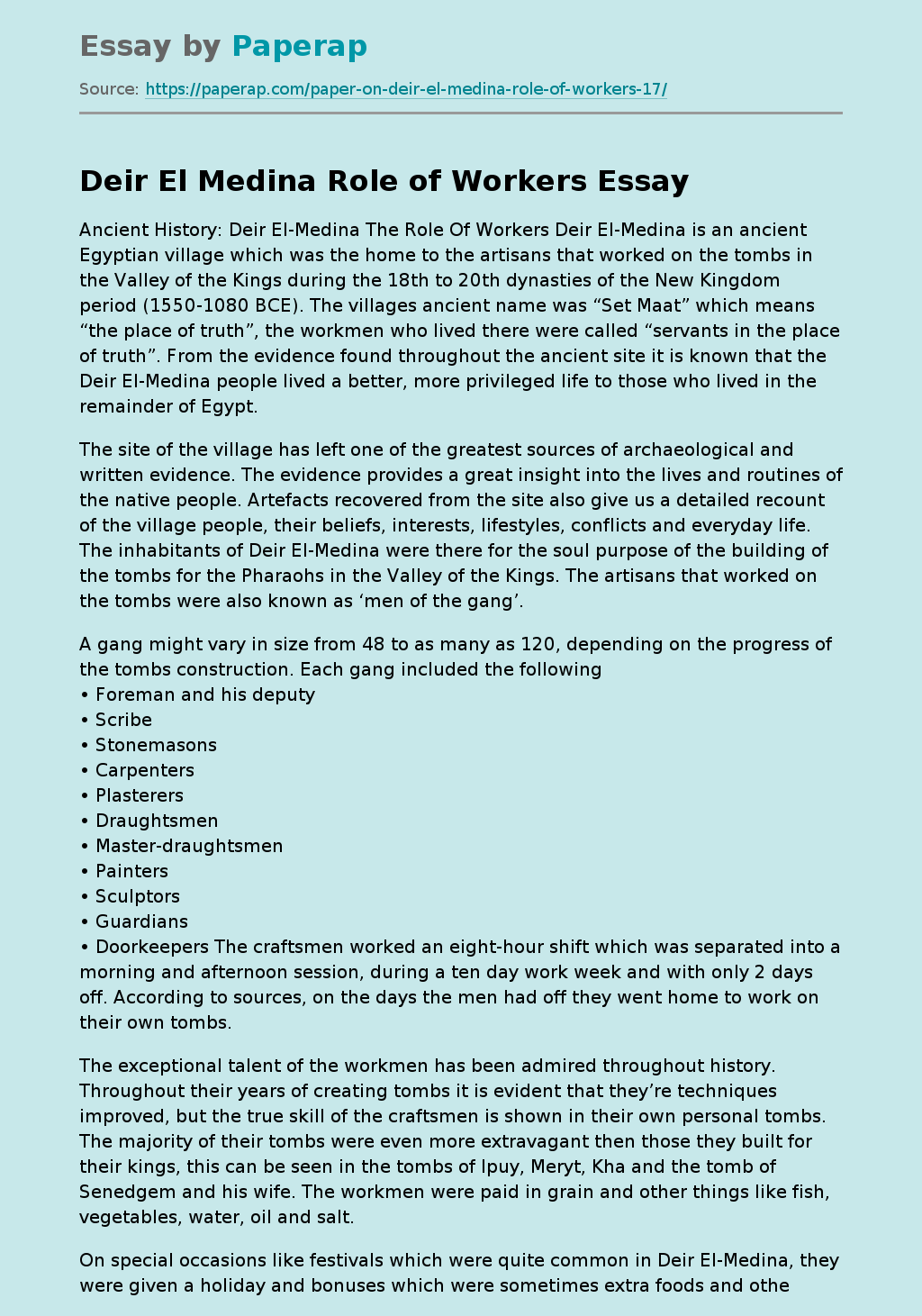Deir El Medina Role of Workers
The following sample essay on Deir El Medina Role of Workers Ancient History: Deir El-Medina The Role Of Workers Deir El-Medina is an ancient Egyptian village which was the home to the artisans that worked on the tombs in the Valley of the Kings during the 18th to 20th dynasties of the New Kingdom period (1550-1080 BCE). The villages ancient name was “Set Maat” which means “the place of truth”, the workmen who lived there were called “servants in the place of truth”.
From the evidence found throughout the ancient site it is known that the Deir El-Medina people lived a better, more privileged life to those who lived in the remainder of Egypt.
The site of the village has left one of the greatest sources of archaeological and written evidence. The evidence provides a great insight into the lives and routines of the native people. Artefacts recovered from the site also give us a detailed recount of the village people, their beliefs, interests, lifestyles, conflicts and everyday life.
The inhabitants of Deir El-Medina were there for the soul purpose of the building of the tombs for the Pharaohs in the Valley of the Kings. The artisans that worked on the tombs were also known as ‘men of the gang’.
A gang might vary in size from 48 to as many as 120, depending on the progress of the tombs construction. Each gang included the following
- Foreman and his deputy
- Scribe
- Stonemasons
- Carpenter
- Plasterers
- Draughtsmen
- Master-draughtsmen
- Painters
- Sculptors
- Guardians
- Doorkeepers
The craftsmen worked an eight-hour shift which was separated into a morning and afternoon session, during a ten day work week and with only 2 days off.
According to sources, on the days the men had off they went home to work on their own tombs.
The exceptional talent of the workmen has been admired throughout history. Throughout their years of creating tombs it is evident that they’re techniques improved, but the true skill of the craftsmen is shown in their own personal tombs. The majority of their tombs were even more extravagant then those they built for their kings, this can be seen in the tombs of Ipuy, Meryt, Kha and the tomb of Senedgem and his wife. The workmen were paid in grain and other things like fish, vegetables, water, oil and salt.
On special occasions like festivals which were quite common in Deir El-Medina, they were given a holiday and bonuses which were sometimes extra foods and other luxuries. Sometimes when the work on the tombs slowed down the workers got laid off but had to make a living doing other things just to survive. The craftsmen were often employed to do other basic tasks. They also increased their income by taking private fees which allowed the workers to construct tombs and burial goods for themselves, their families and other private individuals. There were also records found of the villagers buying and selling goods between themselves.
The town of Deir El-Medina is a unique town in contrast to the rest of Egypt. The town had a surprising amount of equality between men and woman, despite the times they lived in. The archaeological remains leave a great mark on modern day, and the evidence and artefacts found give us an insight into an ancient civilisation and a look at the extraordinary talent of the craftsmen.
Deir El Medina Role of Workers. (2017, Nov 25). Retrieved from https://paperap.com/paper-on-deir-el-medina-role-of-workers-17/

